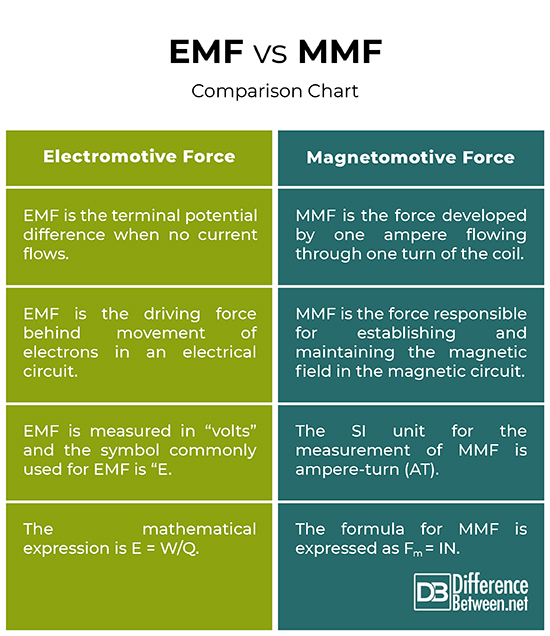Difference Between Electromotive Force and Magnetomotive Force
In comparison to an electric circuit, the magnetomotive force is like the electromotive force. The EMF is the force responsible for the flow of electrons in an electric circuit whereas MMF is the force responsible for driving the magnetic flux or magnetic field lines.

What is Electromotive Force?
Electromotive force, also called EMF, is the driving force behind movement of electrons in an electrical circuit. Electrical charges generate a field around them, and these force fields repel and attract other electrically charged particles. When enough of these charged particles are separated, it creates a potential difference. This difference in potential that gives rise to electric current is called electromotive force. It is the terminal potential difference when no current flows. It is measured in volts and the symbol commonly used for EMF is “E.”
EMF is a type of energy per unit of electric charge that is converted reversibly from chemical, mechanical or other forms of energy into electrical energy. One of the most commonly used forms of electricity generation is the electrochemical reaction or better known as a battery. EMF maintains potential difference inside an active cell. A generator or battery converts energy from one form to another. EMF is the cause and voltage is the effect.

What is Magnetomotive Force?
Magnetomotive force, or MMF, is analogous to the electromotive force and is defined as the driving force behind the creation of magnetic flux in a magnetic circuit. It is the force responsible for establishing and maintaining the magnetic field in the magnetic circuit. It may be considered the factor that sets up the flux. It refers to the magnetic pressure that sets up the magnetic flux within and around an object. It can be created by a permanent magnet or by an electric current flowing in the electric circuit of a coil.
Similar to how EMF is the driving force behind current flowing in an electrical circuit, MMF is the driving force behind the magnetic force in a magnetic circuit. The MMF is the force developed by one ampere flowing through one turn of the coil. The SI unit for the measurement of MMF is ampere-turn (AT). The MMF is also known as the magnetic potential. It refers to the property of a material to give to rise to the magnetic field.
Difference between Electromotive Force and Magnetomotive Force
Definition
– EMF is a type of energy per unit of electric charge that is converted reversibly from chemical, mechanical or other forms of energy into electrical energy. It is the driving force behind movement of electrons in an electrical circuit. MMF, on the other hand, is the force responsible for establishing and maintaining the magnetic field in the magnetic circuit. It is the magnetic pressure that sets up the magnetic flux within and around an object.
Measurement
– EMF is the terminal potential difference when no current flows. It is measured in “volts” and the symbol commonly used for EMF is “E.” The MMF is also known as the magnetic potential. The MMF is the force developed by one ampere flowing through one turn of the coil. The SI unit for the measurement of MMF is ampere-turn (AT).
Formula
– EMF is the energy supplied by a cell or a battery per coulomb (Q) of charge passing through it. The magnitude of EMF is the potential difference across the cell terminals where there is no current flow. The mathematical expression is E = W/Q, where E is the electromotive force, W is the work done, and Q is the charge.
The magnetomotive force (MMF) of a coil is proportional to the product of the number of turns (N) and the current (I). The formula for MMF is expressed as, Fm = IN, where Fm is the MMF in ampere-turns, I is the current and N is the number of turns.
EMF vs. MMF: Comparison Chart

Summary
In a nutshell, EMF is the driving force behind movement of electrons in an electrical circuit. Similarly, MMF is the driving force behind the creation of magnetic flux in a magnetic circuit. EMF is the terminal potential difference when no current flows. It is responsible for producing an electric current in a particular direction. MMF can be created by a permanent magnet or by an electric current flowing in the electric circuit of a coil.
What are MMF and reluctance?
MMF is the driving force behind generation of magnetic fluxes passing through a surface. Reluctance is a concept used in the analysis of magnetic circuits.
What is meant by magnetomotive force?
Magnetomotive force is analogous to the electromotive force and is defined as the driving force behind the creation of magnetic flux in a magnetic circuit. It may be considered the factor that sets up the flux.
How is Magnetising force related to MMF?
The magnetising force (symbol H) is the drop in magnetic force per meter length of a magnetic circuit having consistent reluctance or opposition to the flow of flux.
- Difference Between Caucus and Primary - June 18, 2024
- Difference Between PPO and POS - May 30, 2024
- Difference Between RFID and NFC - May 28, 2024
Search DifferenceBetween.net :
Leave a Response
References :
[0]Kara, Sadik. Electromotive Force and Measurement in Several Systems. Rijeka, Croatia: InTech, 2011. Print
[1]Hampson, Jeffrey and Steven Hanssen. Electrical Trade Principles 5th Edition. Victoria, Australia: Cengage Australia, 2019. Print
